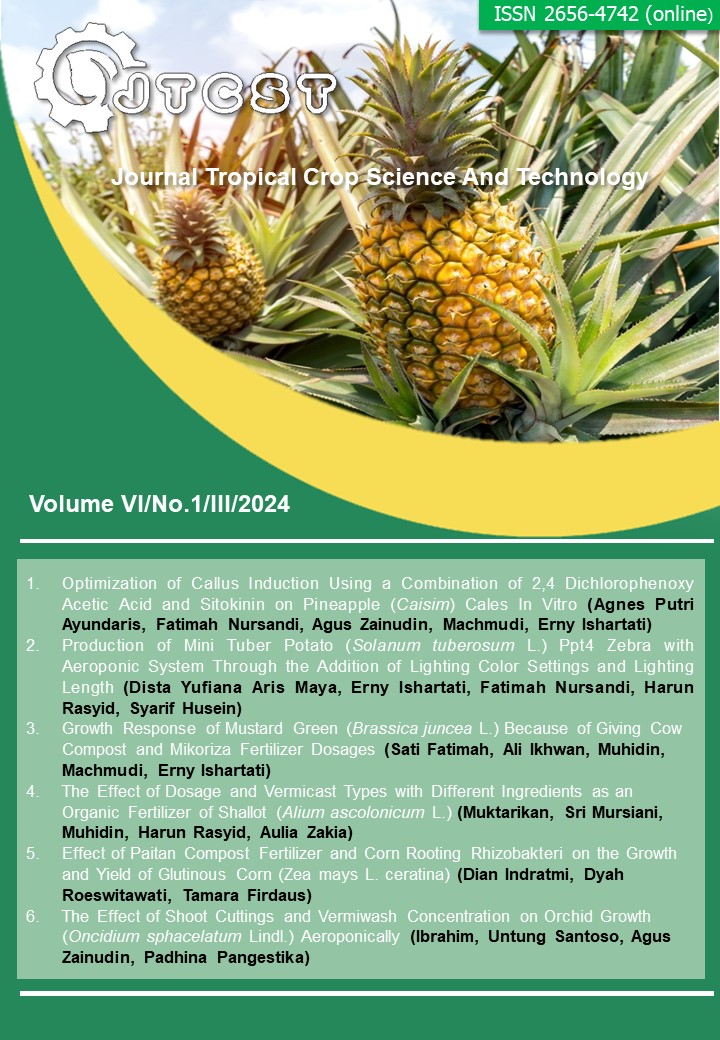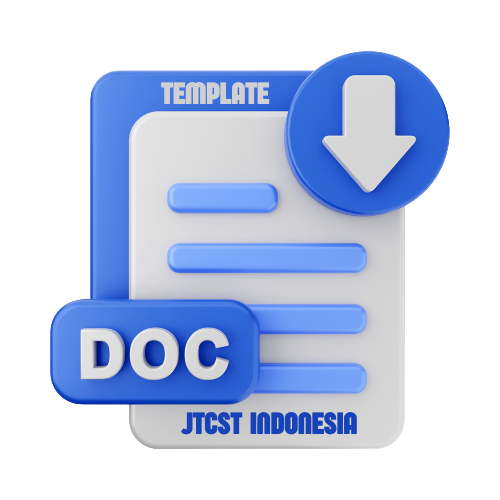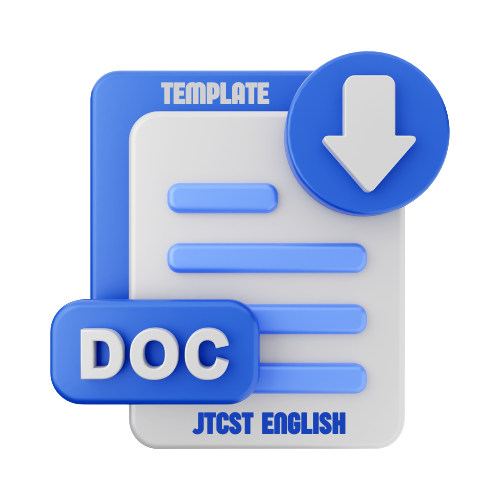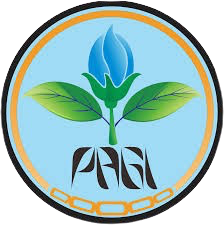Production of Mini Tuber Potato (Solanum tuberosum L.) PPT4 Zebra with Aeroponic System Through The Addition of Lighting Color Settings and Lighting Length
DOI:
https://doi.org/10.22219/jtcst.v6i1.32888Keywords:
Potato, Lighting Colors, Lighting Length, AeroponicAbstract
Potatoes (Solanum tuberosum L.) are carbohydrate-rich crops. Low potato productivity in Indonesia stems from farmers' inadequate access to quality seed potatoes. One solution to this issue is enhancing quality seed potato production, achievable through aeroponic systems. Lighting, whether incandescent or LED, can optimize potato mini tuber propagation in aeroponic systems. Research on lighting's effects on potato growth remains incomplete. This study aims to investigate how lighting color and duration affect mini tuber production of Solanum tuberosum L. PPT4 Zebra using aeroponic systems. Conducted in Jurangkuali, Bumiaji sub-district, Batu, the study employed a split plot design. The main plot consisted of lighting colors (WC): light yellow (WK), white (WP), and purple (WU). Subplots were lighting duration (LP) at 3 hours (LP 3) and 5 hours (LP 5), each replicated four times. Each replication comprised 8 samples, with 18 potato plant cuttings per population. Variables included plant height, stem diameter, leaf count, chlorophyll level, root length, tuber count, tuber diameter, budding seed count, and tuber weight. Data were analyzed using F-tests followed by BNJ tests at a 5% significance level. Results indicated no interaction between lighting color and duration. Purple lighting yielded the highest tuber count and weight, while 3-hour lighting duration yielded superior plant height, stem diameter, leaf count, and root length.
Downloads
References
Agrawal, S.B. 2002. Physiological and Biochemical Responses of Field grown Vicia faba L. plants to supplemental ultra violet-B radiation. Paryavaran Abstracts 19(1-2):1.
Armini, A. N. M., Wattimena & L. W. Gunawan. 1992. Zat Pengatur Tumbuh. Departemen Pendidikan dan Kebudayaan Pusat Antar Universitas Bioteknologi. Institut Pertanian Bogor.
Badan Pusat Statistik. 2014. Kebutuhan Kentang, Impor Kentang, dan Produksi Kentang. (http://bps.go.id) Diakses pada tanggal 10 April 2016.
Bruno, T. J., D. Paris, & N. Svoronos. 2005. CRC Handbook of Fundamental Spectroscopic Correlation Charts. CRC Press. Cambridge University.
Budiarto, K., Y. Sulyo, R. Maaswinkel, & S. Wuryaningsih. 2006. Budidaya Krisan Bunga Potong: Prosedur Sistem Produksi. Pusat Penelitian dan Pengembangan Hortikultura. Lembang.
Dianawati, M., S. Ilyas, G. A. Wattimena, & A.D. Susila. 2013. Produksi Umbi Mini Kentang Secara Aeroponik Melalui Penentuan Dosis Optimum Pupuk Daun Nitrogen. Balai Pengkajian Teknologi Pertanian Jawa Barat. Fakultas Pertanian Institut Pertanian Bogor. J. Horti 23 (1): 47-55
Ermawati, D., D. Indradewa, & S. Trisnowati. 2011. Pengaruh Warna Cahaya Tambahan terhadap Pertumbuhan dan Pembungaan Tiga Varietas Tanaman Kerisan (Chrysanthemum morifolium) Potong. Fakultas Pertanian. Universitas Gajah Mada. Yogyakarta.
Kementerian Pertanian. 2015. Buletin Triwulanan Ekspor Impor Komoditas Pertanian. Pusat Data dan Sistem Informasi Pertanian, Kementerian Pertanian Republik Indonesia. Vol VII No (1).
Laksana, Nana. 2010. Aturan Perbenihan dan Pengembangan Industri Benih Kentang di Indonesia. Direktorat Jendral Hortikultura, Kementerian Pertanian Republik Indonesia.
Muhibuddin, Zakaria, AB, Lisan, E & Baharuddin 2009. Peningkatan produksi dan mutu benih kentang hasil kultur in-vitro melalui introduksi sistem aeroponik dengan formulasi NPK. Prosiding Seminar Nasional Pekan Kentang 2008. Puslitbang Hortikultura. Badan Litbang Pertanian. Kementerian Pertanian. Jakarta. No. 01, Hlm. 102-10.
Pitojo, Setijo. 2003. Benih Kentang. Kanisius. Yogyakarta. Halaman 06.
Proklamasiningsih, Elly., Irfan, D., Diah, R., & Retno, P. 2012. Laju Fotosintesis dan Kandungan Klorofil Kedelai pada Media Tanam Masam dengan Pemberian Garam Aluminium. Journal Fakultas Pertanian. Universitas Udayana Denpasar. Bali.
Rasni. 2013. Aplikasi Zat Pengatur Tumbuh terhadap Pertumbuhan dan Produksi Umbi Mini Kentang (Solanum tuberosum L.) pada Sistem Aeroponik. Jurusan Budidaya Pertanian. Fakutas Pertanian. Universitas Hasanuddin. Makasar.
Ratnasari, Tuti. 2010. Kajian Pembelahan Umbi dan Perendaman dalam Giberelin pada Pertumbuhan dan Hasil Tanaman Kentang (Solanum tuberosum L.). Skripsi Fakultas Pertanian. Universitas Sebelas Maret. Surakarta.
Rosmayati, 2005. Pengaruh Lama Penyinaran Pada Umur Genotipa Kentang dan Ketahanan terhadap Penyakit Hawar Daun Phytophthora. Sekolah Pascasarjana. Institut Pertanian Bogor. Bogor.
Shoimus, Mohammad. 2012. Analisis Efisiensi Alokatif Penggunaan Faktor-Faktor Produksi Usaha Tani Wortel (Daucuscarota L.) di Kecamatan Bumiaji Kota Batu. Fakultas Pertanian Universitas Brawijaya. Malang.
Soeleman, S. & D. Rahayu. 2013. Halaman Organik: Mengubah Taman Rumah Menjadi Taman Sayuran Organik Untuk Gaya Hidup Sehat. PT Agro Media Pustaka. Jakarta Selatan.
Sugito, H., S. B. Wahyu, K. F. Sofjan, & S. Mahmudah. 2005. Pengukuran Panjang Gelombang Sumber Cahaya Berdasarkan Pola Interferensi Celah Banyak. Berkala Fisika No. 8 Hal. 37-44.
Sulistyaningsih , E., B. Kurniasih, & E. Kurniasih. 2005. Pertumbuhan dan Hasil Caisin Pada Berbagai Warna Sungkup Plastik. Ilmu Pertanian No.12 Hal. 65-76
Suryono, A. & R. S. Dewi. 2012. Budidaya Kentang dengan Teknologi Aeroponik. Suara Merdeka. Di upload hari Senin, 27 Agustus 2012.
Sutoyo, 2011. Fotoperiode dan Pembungaan Tanaman. Jurnal Agroteknologi Fakultas Pertanian. Universitas Tribhuwana Tunggadewi. Malang. Vol 11 No. 02
Tyas, Andry. 2010. Budidaya Tanaman Kentang (Solanum tuberosum L.) Diluar Musim Tanam. Program Diploma III Agribisnis Hortikultura dan Arsitektur Pertamanan. Fakultas Pertanian Universitas Sebelas Maret. Surakarta.
Downloads
Published
How to Cite
Issue
Section
License
Copyright (c) 2024 Dista Yufiana Aris Maya, Erny Ishartati, Fatimah Nursandi, Harun Rasyid, Syarief Husein

This work is licensed under a Creative Commons Attribution-ShareAlike 4.0 International License.
Authors who publish with this journal agree to the following terms:
- Authors retain copyright and grant the journal right of first publication with the work simultaneously licensed under a Creative Commons Attribution License that allows others to share the work with an acknowledgement of the work's authorship and initial publication in this journal.
- Authors are able to enter into separate, additional contractual arrangements for the non-exclusive distribution of the journal's published version of the work (e.g., post it to an institutional repository or publish it in a book), with an acknowledgement of its initial publication in this journal.
- Authors are permitted and encouraged to post their work online (e.g., in institutional repositories or on their website) prior to and during the submission process, as it can lead to productive exchanges, as well as earlier and greater citation of published work (See The Effect of Open Access).











